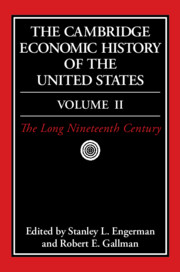Book contents
- Frontmatter
- 1 Economic Growth and Structural Change in the Long Nineteenth Century
- 2 The Economy of Canada in the Nineteenth Century
- 3 Inequality in the Nineteenth Century
- 4 The Population of the United States, 1790–1920
- 5 The Labor Force in the Nineteenth Century
- 6 The Farm, The Farmer, and The Market
- 7 Northern Agriculture and the Westward Movement
- 8 Slavery and its Consequences for the South in the Nineteenth Century
- 9 Technology and Industrialization, 1790–1914
- 10 Entrepreneurship, Business Organization, and Economic Concentration
- 11 Business Law and American Economic History
- 12 Experimental Federalism: the Economics of American Government, 1789–1914
- 13 Internal Transportation in the Nineteenth and Early Twentieth Centuries
- 14 Banking and Finance, 1789–1914
- 15 U.S. Foreign Trade and the Balance of Payments, 1800–1913
- 16 International Capital Movements, Domestic Capital Markets, and American Economic Growth, 1820–1914
- 17 The Social Implications of U.S. Economic Development
- Bibliographic Essays
- Index
- References
6 - The Farm, The Farmer, and The Market
Published online by Cambridge University Press: 28 March 2008
- Frontmatter
- 1 Economic Growth and Structural Change in the Long Nineteenth Century
- 2 The Economy of Canada in the Nineteenth Century
- 3 Inequality in the Nineteenth Century
- 4 The Population of the United States, 1790–1920
- 5 The Labor Force in the Nineteenth Century
- 6 The Farm, The Farmer, and The Market
- 7 Northern Agriculture and the Westward Movement
- 8 Slavery and its Consequences for the South in the Nineteenth Century
- 9 Technology and Industrialization, 1790–1914
- 10 Entrepreneurship, Business Organization, and Economic Concentration
- 11 Business Law and American Economic History
- 12 Experimental Federalism: the Economics of American Government, 1789–1914
- 13 Internal Transportation in the Nineteenth and Early Twentieth Centuries
- 14 Banking and Finance, 1789–1914
- 15 U.S. Foreign Trade and the Balance of Payments, 1800–1913
- 16 International Capital Movements, Domestic Capital Markets, and American Economic Growth, 1820–1914
- 17 The Social Implications of U.S. Economic Development
- Bibliographic Essays
- Index
- References
Summary
INTRODUCTION
The relationship between the farmer and the market in the nineteenth century was frequently ambiguous and fraught with contradictions. Agriculture’s champion, Thomas Jefferson, the philosopher and politician, urged farmers to avoid “the casualties and caprice of customers” through self-sufficiency. But Jefferson the farmer lamented the total want of demand except for our family table” and wished for nothing more than “a rich spot of earth, well watered, and near a good market for the productions of the garden [emphasis added].” While Jefferson exalted the self-sufficient farmer, he was among the first to admit that Americans had a decided taste for navigation & commerce. Indeed, the debt-free farmer with the means of sustenance at his back door was free to choose his level of market involvement in a way open to few, if any, others. For most, self-sufficiency and barter were indicators of market absence, not market avoidance. The “moral economy” where community values dominated individual self-interest, where prices were set by custom, and where reciprocity governed exchanges may have existed, but only temporarily and hardly ever by choice. Settlements on the frontier had little choice but to be self-sufficient. With low population densities, great distances, and high transport costs, few crops could be profitably marketed by the frontier farmer. Under such circumstances, the successful farmer – one who best provided for his family – was indeed the one “who did everything within himself.” Such a person survived and prospered only on the fringes of Von Thünen’s Isolated State, but his isolation did not last long.
- Type
- Chapter
- Information
- The Cambridge Economic History of the United States , pp. 245 - 284Publisher: Cambridge University PressPrint publication year: 2000
References
- 20
- Cited by



